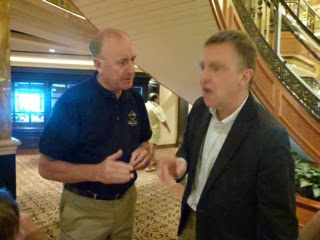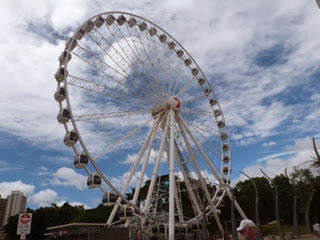Maori settled around the large natural harbour in this part of South Island, New Zealand (the Otago region) from about 1100 AD, but it appears that when Captain James Cook came here in 1776 there were not many Maori still here. In 1848 Scottish migrants arrived and established Dunedin (the Celtic name for Edinburgh). It is New Zealand’s oldest city and it is home to NZ’s first University, The University of Otago.
Milford Sound, Fiordland National Park, South Island, New Zealand
The Tasman Sea was easy on us. The two days it has taken to reach NZ were calm – in fact apart from the massive storms experienced in the first 5 or 6 days after leaving Southampton, the oceans have been kind to us.
Usually the Commodore of the fleet is in command of the flagship, but in fact the Commodore is here with us. I gather that when he took up the position he made it clear that he wanted to move around the fleet, rather than staying on QM2 throughout. He joined us in Sydney and has a few days aboard familiarising himself with the ship’s systems before he takes over from Captain Inger, who goes on leave in Wellington.
Bits and Pieces
Cunard have been producing a number of speakers on each segment and one of them is said to be the Celebrity speaker – John McCarthy, Admiral Lord West and Peter Snow so far and for this leg Roger McGuinn. I will report on him later as he has yet to speak. He was one of the founder members of The Byrds. I have heard him before on QE and am looking forward to hearing him again, hopefully with fresh presentations!
Sydney
Sydney has to be one of the world’s top ciites. I woke to my alarm at 0500 and shot out onto the balcony expecting to see the approach into Sydney Harbour through the Heads. I was too late. By then we were passing the Opera House and approaching our berth. And it was still dark, so an earlier alarm call would not have helped!
Brisbane
Brisbane marks the halfway point on this epic voyage. It is difficult to believe that we have been on the ship for nearly two months, but my waistline proves it.
Fiji and Noumea
Fiji’s welcome was loud and dramatic. At 0700 as we neared the quay we woke to the sound of a marching band. They marched and they danced. They rarely flagged but when they did take a break, a rock group, half hidden in the shed, played electric guitars at full volume.
Memorabilia
When Queen Victoria was being built in 2006/7, Cunard let it be known that they intended to set up an exhibition on the ship displaying memorabilia from the earlier Queens – the Queen Mary, the Queen Elizabeth and the QE2.
International Date Line
We crossed the International Date Line last night at about 2200 hours. There was a slight bump as we went over but no more than that. But sadly Monday 24 February proved to be a nothing day. It was a shame really. It just didn’t happen. I turned on Sky Sports News to find that it was still Monday for you in the UK but we had moved on to Tuesday.
Tahiti and Moorea
We were here in Tahiti last year when we had a fantastic day in the lush cattle country up in the hills.
Pitcairn Island
At 0630 as the sun rose above the horizon a small island lay ahead of us. We arrived off Adamstown at about 0800 as planned and shortlly thereafter a metal longboat packed with people was spotted motoring towards us.











































































